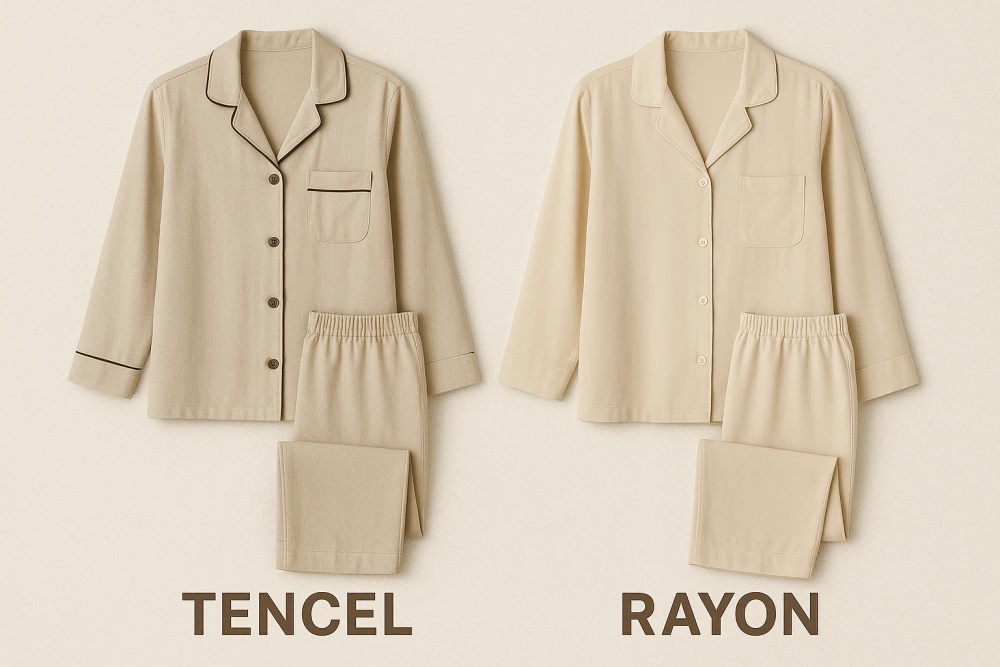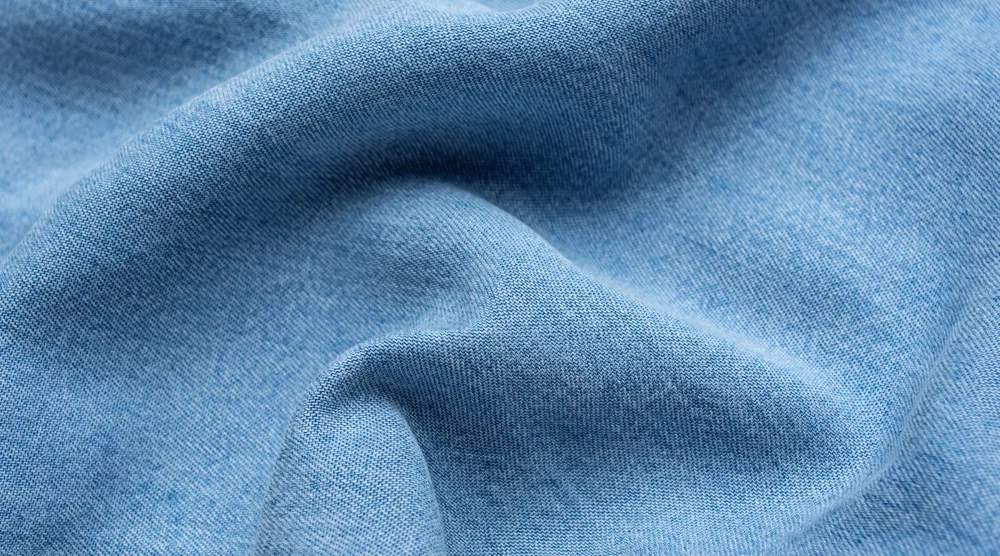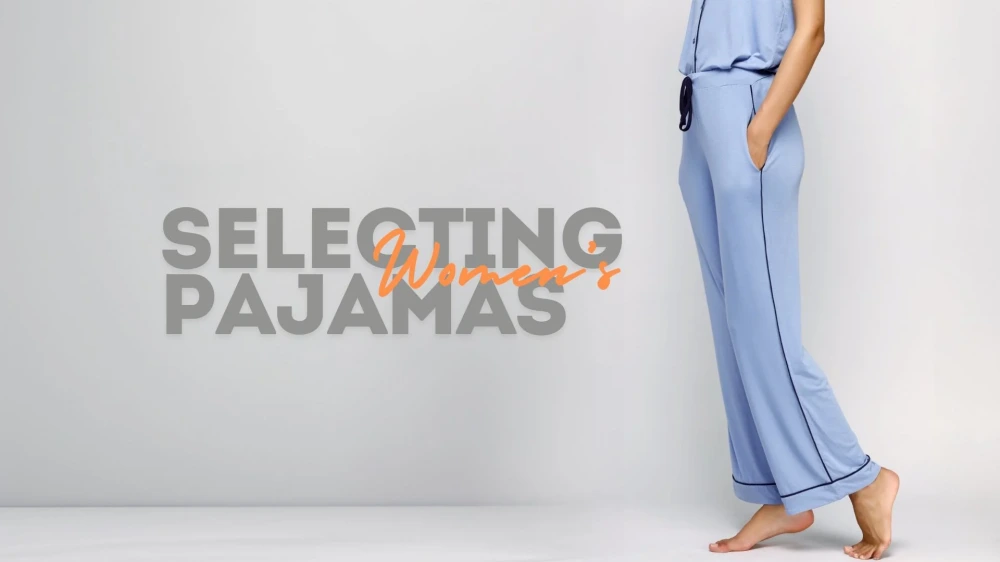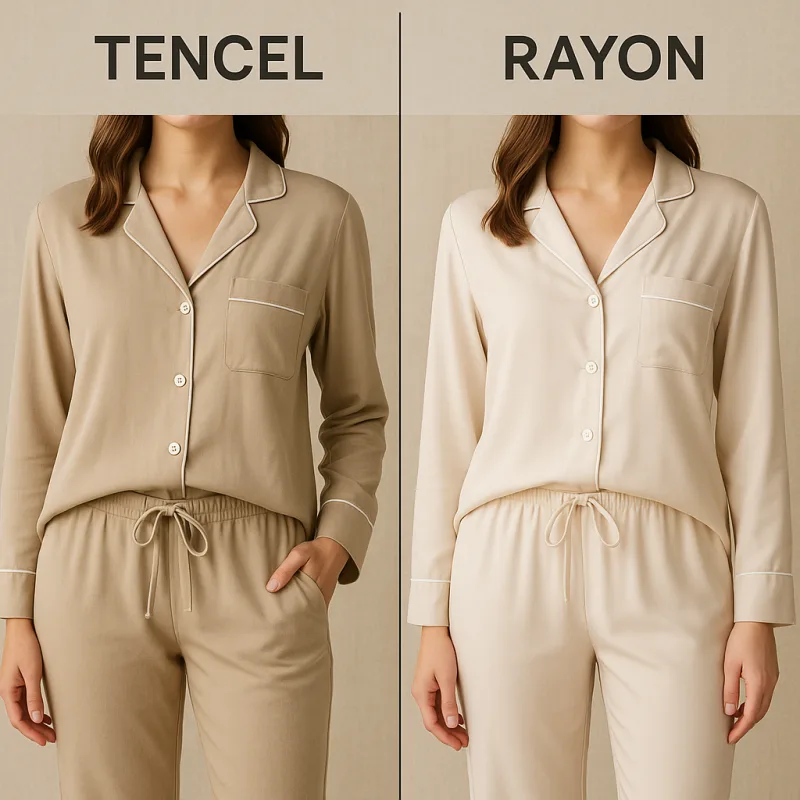If you want the best choice for conscious shoppers, Tencel wins over rayon. Both fabrics feel soft and breathable, making them favorites for pajamas and loungewear. However, the Tencel vs rayon debate comes down to sustainability and comfort.
Tencel uses a closed-loop process that recycles almost all water and solvents, while rayon relies on more water and harsher chemicals. You’ll notice tencel pajamas stay strong and soft, even after many washes. Friendtex offers both options, so you can see the real difference for yourself.
Key Takeaways
Tencel is a sustainable fabric made from wood pulp using a closed-loop process that recycles almost all water and chemicals, making it eco-friendly and gentle on the skin.
Rayon is a soft, breathable fabric made from wood pulp but uses harsher chemicals and water, which can harm the environment if not managed carefully.
Tencel pajamas offer better durability, moisture-wicking, and hypoallergenic benefits, making them ideal for sensitive skin and hot sleepers.
Both fabrics need gentle care; wash with cold water on a gentle cycle and avoid dryers to keep pajamas soft and long-lasting.
Choosing Tencel supports sustainability and comfort, while rayon provides more variety and affordability; Friendtex offers quality options for both.
Tencel vs Rayon

What Is Tencel?
You might have seen Tencel on clothing tags or heard about it as a sustainable fabric. Tencel is actually a brand name for a type of lyocell, which is a third-generation cellulose fiber.
Manufacturers make Tencel from wood pulp, usually from eucalyptus trees grown in sustainably managed forests. The process uses a non-toxic solvent and recycles almost all water and chemicals, making Tencel stand out for its eco-friendliness.
Tencel fabric feels incredibly soft and smooth, almost like silk. It absorbs moisture well, keeps your skin dry, and resists wrinkles. You’ll notice that Tencel pajamas from Friendtex offer a luxurious feel and help regulate your body temperature, so you stay comfortable all night.
Tencel is also hypoallergenic, making it a great choice if you have sensitive skin.
Here’s a quick look at what makes Tencel special:
Made from wood pulp sourced from sustainable forests
Uses a closed-loop production system that recycles 99% of solvents
Soft, breathable, and moisture-wicking
Hypoallergenic and gentle on skin
Durable and wrinkle-resistant
If you care about the environment and want a fabric that feels amazing, Tencel lyocell is a top pick. You’ll even find Tencel sheets and pajamas that combine comfort with sustainability.
What Is Rayon?
Rayon is another popular fabric you’ll find in pajamas and loungewear. It’s a semi-synthetic fiber made from regenerated cellulose, usually from wood pulp. The most common type is viscose rayon, but you’ll also see modal and lyocell as subtypes.
Rayon fabric has a smooth, silky texture and drapes beautifully, which is why it’s often used for sleepwear.
The production of rayon involves dissolving wood pulp in chemicals like sodium hydroxide. This process is more chemical-intensive and can be tough on the environment if not managed carefully.
However, rayon pajamas from Friendtex still offer excellent comfort. They’re lightweight, breathable, and moisture-wicking, so you stay cool and cozy whether you’re lounging or sleeping.
Rayon comes in several forms:
Viscose rayon: The most common, soft, and affordable
Modal: Stronger and more durable, made from beechwood pulp
Lyocell: The most eco-friendly, produced in a closed-loop system (Tencel is a branded lyocell)
Friendtex offers rayon pajamas in different blends, including bamboo rayon and rayon satin, so you can choose the style and feel you like best.
Is Tencel the Same as Rayon?
You might wonder if Tencel and rayon are just different names for the same thing. They’re related, but not identical. Both come from wood pulp and belong to the cellulosic fiber family. The main difference lies in how they’re made and their impact on the environment.
Let’s break it down with a simple table:
Aspect | Rayon (Viscose) | Tencel (Lyocell) |
|---|---|---|
Raw Material Source | Wood pulp from trees (eucalyptus, birch, beech, spruce, bamboo, soybeans, cotton plants) | Wood pulp from sustainably managed forests, mainly eucalyptus |
Fiber Generation | First generation of regenerated cellulose fibers | Third generation of viscose fibers (lyocell) |
Production Method | Chemical-intensive, uses sodium hydroxide and other harsh chemicals | Closed-loop system with non-toxic solvent (NMMO), recycles 99% of chemicals |
Environmental Impact | More waste and pollution, less eco-friendly | Environmentally responsible, less toxic, high chemical recovery |
Sustainability | Not always from sustainable sources | Strong focus on sustainable sourcing and eco-friendly practices |
Tencel lyocell is a type of rayon, but it’s made with a much greener process. Traditional viscose rayon uses more chemicals and energy, which can harm the environment. Tencel stands out as an eco-alternative to rayon because it uses a closed-loop system that recycles almost everything, reducing waste and pollution.
Both Tencel and rayon fabric feel soft and breathable, but Tencel offers better sustainability and eco-friendliness. If you want pajamas that are gentle on your skin and the planet, Tencel pajamas from Friendtex are a smart choice. Rayon pajamas also deliver comfort and style, especially if you love a silky, lightweight feel.
Tip: If you’re looking for a sustainable fabric that’s gentle on the environment and your skin, Tencel lyocell is hard to beat. But if you want more variety in blends and finishes, rayon pajamas give you plenty of options.
Lyocell vs Rayon
Production Process
When you compare lyocell vs rayon, the way each fabric is made stands out. Lyocell, especially Tencel lyocell, uses a closed-loop process that recycles almost all water and solvents. This means the chemicals used in production don’t end up in the environment. Instead, the system captures and reuses them, which makes lyocell much more eco-friendly.
Rayon, on the other hand, follows a more traditional method. Manufacturers use harsh chemicals like carbon disulfide, which can be toxic and hard to recover. This process often releases waste into the environment, causing pollution and health risks for workers.
The difference between lyocell and rayon comes down to how each handles chemicals and waste.
Here’s a quick breakdown:
Lyocell uses organic, nontoxic solvents that are almost completely reusable (up to 99.5% recovery).
Tencel lyocell is made from sustainably harvested wood and uses a patented closed-loop process.
Rayon production relies on a linear chemical model, constantly needing new chemicals and creating more waste.
Earlier generations of rayon did not reuse solvents, leading to significant chemical waste.
If you want pajamas that support sustainable production, lyocell is the clear winner.
Environmental Impact
Eco-friendliness is a big reason why many shoppers choose lyocell over rayon. Tencel lyocell stands out for its low environmental impact. The closed-loop process keeps harmful chemicals out of the environment and reduces water use.
Friendtex, for example, uses Tencel lyocell in their pajamas to offer you a sustainable and comfortable choice.
Rayon’s open-loop process can cause pollution and even lead to bans in some countries. While both fabrics come from wood pulp, lyocell’s advanced production methods make it much more sustainable.
You can also look for certifications to help you shop with confidence. Here’s a table showing some common certifications and what they mean for you:
Certification | What It Means for You |
|---|---|
FSC | Ensures wood comes from responsibly managed forests |
Oeko-Tex | Guarantees safer chemical use and product safety |
Bluesign | Focuses on safe chemistry and worker/environmental safety |
Canopy | Supports the protection of ancient and endangered forests |
Friendtex holds several of these certifications, so you know their products meet high standards for sustainability and eco-friendliness. When you pick lyocell pajamas, you’re making a choice that’s better for you and the planet.
Comfort and Performance
Tencel Fabric Benefits

When you slip into pajamas made from Tencel fabric, you’ll notice how soft and breathable they feel right away. Tencel stands out for its smooth texture and cooling effect, which makes it a favorite for hot sleepers and anyone who wants to stay comfortable all night.
The high absorbency of Tencel means it wicks away sweat quickly, so you stay dry and cozy. This fabric also regulates your body temperature, making it perfect for year-round use.
Tencel is naturally hypoallergenic. Dermatological studies show that it’s gentle on sensitive skin and even helps people with eczema feel more comfortable than cotton.
The fibers are smooth and don’t trap allergens, so you can relax without worrying about irritation. Tencel is also durable, holding up well after many washes and keeping its soft feel.
Rayon Pajama Features
Rayon pajamas from Friendtex offer a soft and breathable experience, too. Rayon fabric mimics the feel of natural fibers, giving you a lightweight and silky touch.
You’ll love how rayon pajamas drape over your body and help regulate your temperature, especially if you tend to get warm at night. The absorbency of rayon helps wick away moisture, so you stay comfortable whether you’re lounging or sleeping.
Rayon comes in different blends, like modal and bamboo rayon, each with unique benefits. Modal, a type of rayon, is especially known for its softness and ability to let air flow freely.
While rayon is not labeled as hypoallergenic, it’s still gentle and suitable for most skin types. Friendtex rayon pajamas are also durable, designed to last and keep their shape.
Friendtex Product Comparison
If you’re choosing between Friendtex Tencel and rayon pajamas, you’ll find both offer impressive comfort and performance. Tencel pajamas give you a naturally hypoallergenic, soft, and moisture-wicking option that’s great for sensitive skin.
Rayon pajamas provide a soft and breathable feel with high absorbency, making them a solid choice for everyday wear. Both fabrics are durable, so you can count on your pajamas to look and feel good wash after wash.
Tip: If you have sensitive skin or want the ultimate in softness, Tencel fabric is a top pick. For variety in blends and finishes, rayon pajamas offer plenty of benefits, too.
Care and Durability
Washing and Maintenance
Taking care of your pajamas helps them last longer and keeps them looking fresh. For both Tencel and rayon, you want to treat them gently. Here’s how you can care for each fabric:
Always check the care label before washing.
Wash Tencel and rayon on a gentle cycle with cold or lukewarm water. Use a mild detergent and skip the bleach.
For extra protection, place your pajamas in a mesh laundry bag.
Hand washing works well, too. Gently swirl the fabric in water and avoid twisting or wringing.
Rinse thoroughly and press out excess water with a towel.
Air dry your pajamas flat or hang them up away from direct sunlight and heat.
If you need to iron, use low heat and a pressing cloth. Steaming is a safe option.
Tip: Avoid using a dryer for rayon and Tencel. Heat can cause shrinkage and damage the fibers.
Longevity
You want pajamas that stay soft and vibrant after many washes. Tencel stands out as a durable choice. It resists wrinkling and holds its shape, even after repeated laundering.
You might notice a little shrinkage (about 3%) the first time you wash Tencel, but it stays true to size after that. The color stays rich, thanks to the fabric’s high absorbency.
Rayon feels soft and smooth, but it needs a bit more care. It can shrink if exposed to heat, so always use cold water and avoid the dryer. Rayon may also bleed color during the first few washes, so wash it separately or with similar colors. Drying in the shade helps keep colors bright and prevents fading.
Everyday Use
Both Tencel and rayon pajamas from Friendtex are designed for comfort and daily wear. Tencel pajamas are especially durable, keeping their softness and color even with frequent use.
You can count on them to look and feel great night after night. Rayon pajamas offer a lightweight, silky feel that’s perfect for lounging or sleeping. With the right care, they stay comfortable and stylish for a long time.
If you want pajamas that handle everyday life and lots of washes, Tencel is a smart pick. Rayon pajamas give you a soft, luxurious feel, but remember to treat them gently for the best results.
Pros and Cons: Rayon Versus Tencel
Tencel Pros and Cons
When you look at Tencel, you’ll notice it stands out for its eco-friendly qualities and comfort. Here’s what you can expect:
Pros:
Made from sustainably harvested wood, often eucalyptus, grown without pesticides or irrigation.
Produced in a closed-loop system that recycles almost all water and solvents, so it’s much more sustainable than most fabrics.
Uses fewer toxic chemicals, making it safer for workers and the environment.
Feels soft, smooth, and breathable—perfect for sensitive skin.
Strong, durable, and holds up well after washing.
Certified by trusted organizations like OEKO-TEX and EU Ecolabel.
Cons:
Sometimes costs a bit more than conventional rayon.
May shrink slightly on the first wash, but stays true to size after that.
If you want pajamas that are gentle on your skin and the planet, tencel is a top choice.
Rayon Pros and Cons
Rayon is popular for its silky feel and affordability, but it comes with some trade-offs. Here’s what you should know:
Pros:
Soft, lightweight, and breathable—great for pajamas and loungewear.
Drapes beautifully and feels cool against your skin.
More affordable than many other fabrics.
Offers lots of variety, including blends like bamboo rayon and modal.
Cons:
Production uses harsh chemicals like carbon disulfide and sodium hydroxide, which can harm workers and pollute water.
Not made in a closed-loop system, so chemical waste can end up in the environment.
Loses strength when wet, so you need to wash it gently.
It can fade or shrink if not cared for properly.
Large-scale production sometimes leads to deforestation and loss of biodiversity.
Rayon gives you comfort and style, but it’s important to check for sustainable sourcing and certifications.
Quick Comparison Table
Here’s a quick look at rayon versus tencel so you can compare at a glance:
Feature | Rayon | Tencel (Lyocell) |
|---|---|---|
Source | Wood pulp (varied sources) | Sustainably grown eucalyptus |
Chemical Processing | High, toxic | Low, non-toxic |
Water/Energy Use | High | Low |
Closed-Loop System | No | Yes |
Comfort | Soft, breathable | Softer, hypoallergenic |
Durability | Needs gentle care | Strong, easy to maintain |
Price | Usually lower | Slightly higher |
Certifications | Few | Many (OEKO-TEX, EU Ecolabel) |
Choosing between rayon and tencel depends on what matters most to you—eco-friendliness, comfort, or price.
Choosing the Right Pajamas

For Eco-Conscious Shoppers
If you care about the planet, you probably want pajamas that match your values. Tencel stands out as an eco-friendly option. It comes from sustainably sourced wood pulp and uses a closed-loop process that recycles almost all water and chemicals. This means less pollution and waste.
Tencel also needs less water and energy than rayon or cotton, and it uses fewer dyes, which helps keep rivers clean. You can even compost pure Tencel fabric when it wears out. Rayon, while soft and comfortable, often uses more chemicals and sometimes comes from endangered forests.
If you want to make sure your pajamas are truly sustainable, look for trusted suppliers like Friendtex, which use certified materials and ethical manufacturing. You can also check for certifications like OEKO-TEX or GOTS to be sure your pajamas are safe for you and the environment.
Tip: Tencel pajamas may cost a bit more, but they last longer and have a smaller environmental footprint. That makes them a smart choice for eco-conscious shoppers.
For Comfort Seekers
You want pajamas that feel amazing every night. Both Tencel and rayon offer softness and breathability, but each has its strengths. Here’s what to look for:
Tencel pajamas are hypoallergenic and gentle on sensitive skin. The silky texture reduces friction and irritation.
The fabric wicks away moisture and keeps you cool, which is great if you get hot or have night sweats.
Tencel resists odors and stays fresh longer.
Rayon pajamas feel lightweight and have a cool, flowy touch. Many people love them for their elegant drape and comfort in warm weather.
Both fabrics are available in different blends and styles, so you can find the perfect fit for your needs.
If you have sensitive skin or want pajamas that stay soft and fresh, Tencel is a top pick. If you prefer a silky, affordable option with lots of style choices, rayon pajamas are a great choice.
Friendtex Recommendations
Here’s a quick guide to help you choose from Friendtex’s pajama collection:
Need/Preference | Best Friendtex Option | Why Choose It? |
|---|---|---|
Eco-friendly option | Tencel Pajamas | Sustainable, closed-loop process, gentle on skin |
Sensitive skin | Tencel Pajamas | Hypoallergenic, soft, moisture-wicking |
Affordable comfort | Rayon Pajamas | Lightweight, breathable, stylish |
Customization | Tencel or Rayon Pajamas | Wide range of blends, sizes, and designs |
You can trust Friendtex for quality and sustainability, whether you pick Tencel or rayon. If you want the best for the planet and your skin, Tencel pajamas are hard to beat. If you want variety and value, rayon pajamas are a solid choice.
Conclusion
You’ve seen how Tencel and rayon stack up for comfort and sustainability. Tencel stands out as the top pick for conscious shoppers, thanks to its closed-loop process, renewable sourcing, and certifications from trusted organizations.
Sustainability experts recommend Tencel for its breathability, biodegradability, and gentle feel. If you want pajamas that match your values, check for clear certifications, ask brands about their processes, and choose trusted names like Friendtex. Mindful shopping helps you find pajamas that feel good and do good.
FAQ
What makes Tencel pajamas a good choice for sensitive skin?
Tencel feels super soft and smooth. It’s hypoallergenic, so it won’t irritate your skin. If you have allergies or eczema, you’ll love how gentle Tencel pajamas feel every night.
Can I machine wash both Tencel and rayon pajamas?
Yes, you can! Just use cold water and a gentle cycle. Skip the bleach. For best results, air-dry your pajamas. This keeps them looking and feeling great.
Do Tencel and rayon pajamas shrink after washing?
Tencel may shrink a little the first time, but it stays true to size after that. Rayon can shrink if you use hot water or a dryer. Always follow the care label.
Which fabric is better for hot sleepers?
Tencel works wonders for hot sleepers. It wicks away moisture and helps regulate your temperature. Rayon also feels cool and breathable, but Tencel offers extra comfort if you get warm at night.
Are Friendtex pajamas eco-friendly?
Absolutely! Friendtex uses sustainable materials and holds top certifications. You can feel good knowing your pajamas are made with care for both you and the planet.


